Infant abduction
While infant abductions are rare, a few occur every year. Pediatricians should be aware of preventive steps to take in hospitals and how to educate parents in the art of protecting their newborns.
Infant abductions: Preventing the unthinkable
By Andrew J. Schuman, MD
While infant abductions are rare, a few occur every year. Pediatricians should be aware of preventive steps to take in hospitals and how to educate parents in the art of protecting their newborns.
Most parents and pediatricians give little thought to the possibility that a newborn infant could be abducted from a hospital nursery or pediatric ward. Although abductions are not a frequent occurrence, it is estimated that between 12 and 18 infants are abducted by nonfamily members from health-care facilities in the United States each year. Between 1983 and 1997 a total of 171 infant abductions were reported to the National Center for Missing and Exploited Children (NCMEC); 11 infants are still missing. A breakout of the states in which these abductions took place is shown in Figure 1.
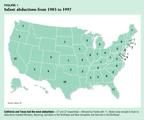
The NCMEC plays a central role in the recovery of abducted children (see "About the NCMEC" for details.) In addition, since 1989, NCMEC has published guidelines to help hospital personnel and law enforcement agencies guard against this threat. Now in its fifth edition, For Healthcare Professionals: Guidelines on Prevention and Response to Infant Abductions represents the cooperative efforts of the NCMEC, the Office of Juvenile Justice and Delinquency Prevention (OJJDP), the Association of Women's Health, Obstetric, and Neonatal Nurses (AWHONN), the National Association of Neonatal Nurses (NANN), and the International Association for Healthcare Security and Safety (IAHSS). It is considered the standard reference for medical and law enforcement personnel.1
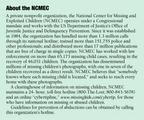
I will review the problem of infant abduction from health-care facilities and the latest NCMEC guidelines for preventing this act. Pediatricians can help hospital administrators determine how susceptible their community hospital is to infant abductions and plan corrective action.
A likely abductor
According to Jeff Karpovich, former board member of the Southeastern Safety and Security Council, hospitals witnessed an increase in infant abductions in the 1980s when Labor, Delivery, and Recovery (LDR) care became popular. In facilities that adopted LDR care, mothers labored, delivered, and cared for their infants in the same room, and infants rarely needed to be placed in a nursery area. Although many parents and nurses lauded this personal approach to the birthing process (and it continues to be popular today), LDR care renders newborns extremely susceptible to abductions.2
In a typical hospital newborn abduction, an appropriately attired individual poses as a health-care worker such as a nurse, social worker, laboratory technician, or volunteer. The abductor, almost always female,1 is given the infant by the mother after telling the mother that the newborn needs to have a procedure done--blood drawn, photograph taken, or weight recorded. The mother hands her baby over to the abductor, confident that the infant will be returned shortly. Once in possession of the infant, the abductor may leave the maternity floor via a stairwell and exit from the hospital. Depending on the situation and time of day, the abduction may not be discovered until several hours later.
Abductors typically range in age from 12 to 50; they are often overweight and have no previous criminal record. Profiles of infant abductors reveal that they are compulsive, have low self-esteem, and may have faked one or more pregnancies in the past. They tend to be convincing liars, and usually visit nursery and maternity units prior to the abduction to assess the floor layout and devise an escape route. Often they live in the community where the abduction takes place. Why is a newborn stolen? A baby is taken to replace an infant that died or to salvage a relationship with a husband or boyfriend.3
According to NCMEC statistics, roughly two thirds of the documented infant abductions between 1983 and 1997 were from hospitals, with the rest of the infants taken from homes and other locations such as malls and parking lots (Table 1). Forty-two percent of hospital abductions took place in hospitals with between 200 and 400 beds; 30% in hospitals with more than 600 beds; 16% in hospitals with 400 and 600 beds; and 12% in hospitals with fewer than 200 beds. Usually, the abductor does not target a specific infant but rather picks up any infant when an opportunity presents itself. Fortunately, another typical personality trait of abductors is responsible for the expeditious recovery of most abducted infants. The abductor needs to show off her new infant to others. For this reason, using the media to publicize an abduction often leads to a tip to law enforcement or the media by individuals who come in contact with the abductor and the abducted infant.1
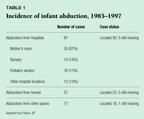
Tightening security
Sadly, it often requires an infant abduction to motivate a hospital to improve security measures, including parent and nursing education as well as changes in the hospital facility itself, such as better camera surveillance and state-of-the-art tag alarm systems. According to companies that market nursery security systems, only 10% to 15% of the hospitals in the United States have installed high-tech infant-tag alarm-security systems.
Since 1995 the incidence of infant abductions has declined by 64%, due in large measure to the efforts of NCMEC to publicize the problem and to educate parents and medical personnel about preventing abductions. John Raburn, Jr., a vice president of NCMEC, has trained over 45,000 health-care providers and performed site visits to almost 700 hospitals during the last eight years. Mead Johnson Nutritionals has supported the NCMEC's efforts by providing educational videotapes and monographs for hospitals' administration and nursing staff and free pamphlets for distribution to parents.2 The focus of this training and educational material is on "hardening the target"--improving parental and nursing awareness of the potential for abduction, upgrading hospital security, and improving methods of infant identification.
The NCMEC guidelines include a 19-page assessment guide for health-care facilities that outlines strategies for prevention of infant abductions. A self-assessment by a health-care facility provides administrators and nursing directors with useful information about how susceptible the facility is to infant abductions and identifies measures that can and should be implemented to improve the situation.
The first step: Make parents aware
Any program developed to prevent infant abductions begins with parental education. Mead Johnson's pamphlet, Safeguard Their Tomorrows, covers key elements of preventing abductions from the hospital and home. It includes the following suggestions:
- Well before their baby's delivery date, parents should investigate the security procedures at the hospital where the infant's birth will take place and request a written description of such policies.
- After the infant's birth, the parents should never leave the infant out of their direct line of sight, even to take a nap or use the bathroom. If a parent must leave the room, the newborn should be returned to the nursery or watched by a family member.
- The infant should never be handed to anyone who does not have proper hospital identification. Before surrendering a newborn to anyone, a parent should identify the person as a nurse or other member of the hospital's staff.
- Parents should always question unfamiliar people who may want to enter the hospital room, and notify the nursing staff of any suspicious behavior.
- When a newborn needs to be taken for a test, the mother should find out who ordered the test, where the test is going to be performed, and how long the procedure will take.
- Before parents take their infant home from the hospital, they should be sure they have a picture of their child and also a written description of the baby's physical characteristics.
- Caution is also advised in announcing the birth of a baby. Newspaper birth announcements should not include the family's home address. Outdoor decorations announcing the birth of the baby should also be avoided.
Creating a "hard target"
The guidelines for health-care professionals suggest that hospitals implement a comprehensive, multidisciplinary program to prevent infant abductions. This program should involve administrators, nursing personnel, physicians, security, and risk-management personnel. Every hospital needs to put its policies in writing and develop procedures both for preventing abductions and for retrieving an infant in the event that an abduction occurs. Nurses play a critical role in such a plan, as do security tools such as a camera surveillance system or infant tag alarm system. High tech systems displayed conspicuously can deter potential abductors. They can also document an abduction if one occurs, and expedite an infant's return.
According to the guidelines, the first preventive measures should be performed at the time of birth. Identically numbered identification bands are placed on the infant, mother, and father. Before the baby leaves the birthing room, the hospital staff should perform a full physical assessment and record the findings in the baby's chart, take a photo of the baby, and record the infant's footprint, making sure ridge detail is as accurate as possible. Cord blood can also be sent to the laboratory for the purpose of future identification by methods that will be discussed shortly.
Access control is one of the main deterrents to abductions. A walk through the nursery and maternity floor can quickly identify escape routes through stairways and easy access to elevator bays. Alarms with time-delay locks should be installed on all stairwell and exit doors near the maternity ward, the pediatric ward, and the nursery. These doors should have self-closing hardware and remain locked at all times. A strategically placed security camera system is also extremely important. The cameras should be located in the nursery, stairwells, elevators, and hallways, and positioned to capture visitors' faces.
Previously extremely expensive, infant tag alarm systems can now be installed for less than $30,000. A popular one is Instantel's (Kanata, Ontario) Hugs Infant Protections System. It consists of tamper-proof bracelets worn by infants; sensors placed at nursery and unit exits; local area receivers that relay tag signals; and a computer. Alarms sound for a variety of reasons: The bracelet is cut; someone tries to move an infant through a protected doorway without authorization; an infant is near an open doorway; or an infant fails to return to the maternity unit within a specified time. Another system is available from Prosec Protection Systems Inc. It consists of a lightweight electronic device attached to an umbilical cord clamp. A small antenna placed in the ceiling picks up signals from the device. When the baby enters the area with the antenna, a coded signal is transmitted to a monitor, triggering an alarm if someone seems to be moving the infant out of a secure area. Still another system is EXI Wireless Systems Halo Infant Protection System. This device uses a "P-Tag" transponder placed on the infant's ankle with a hospital band. If someone lifts the tag from the skin in order to remove it, a signal is sent to a grid of receivers on the ceiling, and an alarm goes off. The sensing devices worn by the baby in these three systems are shown in Figure 2. The floor plan in Figure 3 shows where sensors, alarms, and other security devices can be placed in the building.
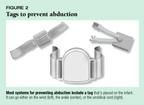
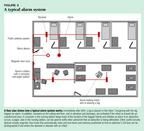
Another important safety measure is to make sure that all hospital personnel (including pediatricians) conspicuously display identification badges on their clothing, color-coded to indicate their job. All nursery personnel need to be alert to unusual behavior displayed by any visitors to the maternity and nursery unit. Only authorized staff members are allowed to transport newborns. They should never carry infants. Instead, they should push the babies in bassinets and never leave the infants in hallways without direct supervision, even for a moment. Staff should always transport infants to mothers or other locations one at a time, never in groups. Signs outside patients' rooms and nurseries should not display mothers' or infants' full names, and identification cards should not include the family's home address. Of course, hospitals should not release personal information about newborns and mothers to the media.
Even though a hospital seems to have taken every precaution, an abduction can still occur. So it's important for a hospital to have a response plan in place should someone walk away with an infant. The plan can be triggered by a staff member saying a code word on the public address system. If they hear this alert, the rest of the staff immediately knows what steps to take. "Just in case" discusses a good plan to follow.
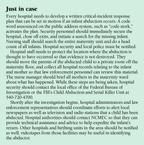
Infant identification
Pediatricians need to be aware of the various methods that now exist for identifying infants who have been abducted. These include foot-printing, DNA genotyping, human leukocyte antigen (HLA) typing, and antibody profiling.
Footprints. For decades hospitals have routinely placed footprints of newborns in their charts, but recently physicians have challenged this practice, saying that footprints are of little use in identifying infants.4,5 For this reason, the American Association of Pediatricians and American College of Obstetrics and Gynecology no longer recommend footprinting as a standard of care in their latest joint perinatal guidelines. However, these organizations indicate that the practice can be continued if hospitals wish to do so.
Surveys indicate that some 90% of hospitals in the United States footprint newborns.6 Law enforcement organizations and NCMEC continue to recommend that hospitals obtain footprints from every newborn, that local FBI officials train nurses in footprinting techniques, and that children be footprinted again when the opportunity presents itself, such as during admission to a pediatric ward. Members of law enforcement groups feel strongly that any information that documents an infant's identity (including footprints, blood tests, written descriptions, and photos) aids in an infant's recovery.
DNA genotyping and HLA typing. These methods are expensive and take time. As a result, they have little practical value in the quick identification of an infant recovered by the police and thought to have been abducted. In addition, unlike footprints (and fingerprints), which are unique to each individual, these methods cannot distinguish between identical twins.6
Individual-specific antibody profiling is the latest high-tech method to link a mother to her infant. An antibody profile can require as little as 5 mL of blood and takes about 90 minutes to perform. An infant acquires an antibody profile from his or her mother before birth and does not develop a unique immunoglobulin profile until 1 year of age.7 Thus, in the case of an abduction, the mother's blood can be tested to obtain the infant's antibody profile.
Safety first
Although infant abductions are infrequent, hospitals need to do everything possible to prevent these events. Parents should familiarize themselves with the abduction-prevention policies of the hospital where their infant will be born, and hospital administrators need to assess existing security measures. A sophisticated surveillance system or infant tag alarm system will "harden the target" and make abduction much more difficult. By reviewing the current NCMEC guidelines, pediatricians can easily determine if the local hospital is well prepared and make appropriate recommendations. Their role as advocates for children's safety begins as soon as a child is born.
THE AUTHOR is Adjunct Professor of Pediatrics at Dartmouth Medical School, Lebanon, NH, and practices pediatrics at Hampshire Pediatrics, Manchester, NH. He is a Contributing Editor for Contemporary Pediatrics.
ACKNOWLEDGMENT
The author would like to thank Ms. Virginia A. Mason-Schuman for her assistance in the preparation of this article.
REFERENCES
1. Rabun JB: For Healthcare Professionals: Guidelines on Prevention of and Response to Infant Abduction, ed 5. Arlington, VA, National Center for Missing and Exploited Children, June, 1998
2. Karpovich J: Understanding national guidelines for infant abduction prevention and response. J Health Prot Manage 1996;13(1):63
3. Quayle C: Robbing the cradle. Health Facilities Management 1997;10(8):20
4. Thompson JE, Clark DA, Salisbury B, et al: Footprinting the newborn infant: Not cost-effective. J Peds 1981;99 (5):797
5. Butz AM, Oski FA, Repke J, et al: Newborn identification: Compliance with AAP guidelines for perinatal care. Clin Pediatr 1993;32(2):111
6. Stapleton ME: Best foot forward: Infant footprints for personal identification. FBI Law Enforcement Bulletin 1999; 63(11):14
7. Unger TF, Strauss A: Individual-specific antibody profiles as a means of newborn infant identification. J Perinatology 1995;15(2):152
Andrew Schuman. Infant abduction. Contemporary Pediatrics 1999;10:93.